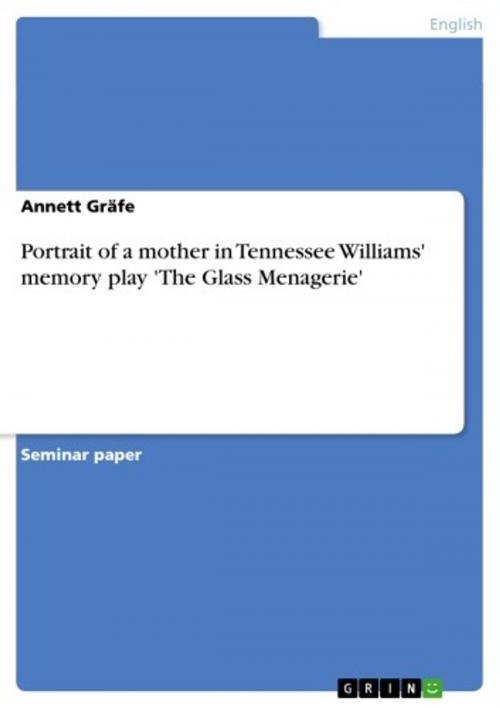Portrait of a mother in Tennessee Williams' memory play 'The Glass Menagerie'
Nonfiction, Entertainment, Drama, Anthologies| Author: | Annett Gräfe | ISBN: | 9783638685825 |
| Publisher: | GRIN Publishing | Publication: | April 16, 2007 |
| Imprint: | GRIN Publishing | Language: | English |
| Author: | Annett Gräfe |
| ISBN: | 9783638685825 |
| Publisher: | GRIN Publishing |
| Publication: | April 16, 2007 |
| Imprint: | GRIN Publishing |
| Language: | English |
Seminar paper from the year 2007 in the subject American Studies - Literature, grade: 1,0, http://www.uni-jena.de/ (Institut für Anglistik/Amerikanistik), course: Classics of Modern American Drama, 18 entries in the bibliography, language: English, abstract: Of particular interest for this paper is the juxtaposition of conflicting traits in Amanda's character. On the one hand, she is characterized by critics as the good mother and perpetuator. On the other hand, she is the terrible, cruel mother and perpetrator. These different characteristics seem to be directly connected to Amanda's relationship to her children. For her daughter she is the good mother, trying everything to ensure her daughter's security in the future. Her son experiences his mother's treatment as suffocating and restricting for his dreams and ambitions. Yet, both of these different attitudes seem to be motivated by the same disposition in Amanda: the love and devotion of a mother for her children. Consequently, there must be other reasons that motivate Amanda's behavior. This paper is going to consider the social and economical situation in the USA at the time of the play, Amanda's glorification of her own past and the fact that the play is Tom's memory for a combination of these three points seem to be the reason why Amanda is portrait as such an ambiguous character in the drama. To begin with, the relevant social and economic circumstances in the USA during the time of the play are going to be analyzed. Amanda's glorification of her past is then discussed followed by the analysis of the influence of Tom's memory on the portrayal of Amanda in the play. Finally, the results of the analysis of the three factors are applied to the relationship of Amanda and her children.
Seminar paper from the year 2007 in the subject American Studies - Literature, grade: 1,0, http://www.uni-jena.de/ (Institut für Anglistik/Amerikanistik), course: Classics of Modern American Drama, 18 entries in the bibliography, language: English, abstract: Of particular interest for this paper is the juxtaposition of conflicting traits in Amanda's character. On the one hand, she is characterized by critics as the good mother and perpetuator. On the other hand, she is the terrible, cruel mother and perpetrator. These different characteristics seem to be directly connected to Amanda's relationship to her children. For her daughter she is the good mother, trying everything to ensure her daughter's security in the future. Her son experiences his mother's treatment as suffocating and restricting for his dreams and ambitions. Yet, both of these different attitudes seem to be motivated by the same disposition in Amanda: the love and devotion of a mother for her children. Consequently, there must be other reasons that motivate Amanda's behavior. This paper is going to consider the social and economical situation in the USA at the time of the play, Amanda's glorification of her own past and the fact that the play is Tom's memory for a combination of these three points seem to be the reason why Amanda is portrait as such an ambiguous character in the drama. To begin with, the relevant social and economic circumstances in the USA during the time of the play are going to be analyzed. Amanda's glorification of her past is then discussed followed by the analysis of the influence of Tom's memory on the portrayal of Amanda in the play. Finally, the results of the analysis of the three factors are applied to the relationship of Amanda and her children.















